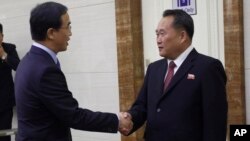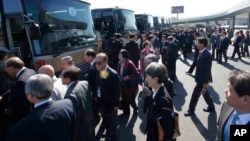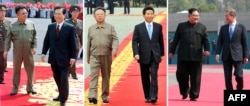South Korea’s Unification Minister, Cho Myoung-gyon, led a delegation of about 160 others to Pyongyang Thursday along with Democratic Party leader Lee Hae-chan. The three-day trip is set to commemorate the 11th anniversary of the October 4 Declaration, signed in 2007 by then-South Korean President Roh Moo-hyun and his counterpart North Korean leader Kim Jong-il during their inter-Korean summit. The festivities are scheduled to take place Oct. 5.
“We make this trip to Pyongyang in the spirit of the October 4 Declaration,” Cho told the traveling pool of reporters before departing Seoul. “The government authorities, together with political parties, municipal government officials and civic groups, will return after creating a chance to solidify inter-Korean reconciliation, cooperation and peace.”
The envoys will travel to Pyongyang along the direct western route, as South Korean President Moon Jae-in did last month for his third summit with Kim Jong Un.
South Korean delegation
The South Korean government is sending 30 individuals as part of the contingent visiting Pyongyang. In addition, the unification minister, the head of the Cultural Heritage Association, members of the national assembly, individuals from political parties, and local officials will make the trip. More than 80 people from various private organizations will join them.
Those from South Korea will visit several “major facilities” in the North and view an art performance; however, the unification ministry hasn’t provided specifics. It’s also unclear if the group will meet North Korean leader Kim Jong Un during their visit.
“I plan to discuss ways to implement the Pyongyang Joint Declaration with North Korean authorities,” Cho said at a meeting earlier this week.
Specifically, Cho mentioned the proposed visit to South Korea by Kim Jong Un, which would be the first of its kind since the end of the Korean War. If “a North Korean leader visits Seoul for the first time since the division of the nation,” said Cho, such a trip would boost mutual trust and facilitate the development of a peace regime on the peninsula.
Past is prologue
A chief criticism by experts of the declarations signed by President Moon and U.S. President Donald Trump with the North Korean leader, is that the language appears to recycle that used in the past and offers little in the way of specific details.
For example, the 2007 Pyongyang declaration being celebrated called for the “Positive implementation of the June 15 Joint Declaration (2000),” “Developing Inter-Korean Relations into those of Mutual Respect and Trust,” and “Reducing Military Tension and Building Trust” as it’s first three items.
Reviewing the September 2018 Pyongyang Joint Declaration, similar passages are found.
“The two sides agreed to adopt the Agreement on the Implementation of the Historic Panmunjom Declaration in the Military Domain as an annex to the Pyongyang Declaration, and to thoroughly abide by and faithfully implement it” appears in the first item covered in September’s declaration, as its counterpart did in 2007.
Likewise, Moon and Kim agreed in September “to consistently and continuously develop inter-Korean relations for national reconciliation and cooperation, and firm peace and co-prosperity, and to make efforts to realize through policy measures the aspiration and hope of all Koreans that the current developments in inter-Korean relations will lead to reunification.”
Moon stated that the primary goal of his September trip to Pyongyang was to foster better inter-Korean relations. His efforts manifested not only in ways to reduce military tensions, but also the proposals to link railways and roads, in addition to re-opening of tourism and industrial sites, when “conditions ripe.” The development of “Inter-Korean economic cooperation” was also promised in 2007.
A rising Moon
Since returning from Pyongyang, President Moon has seen his popularity jump from a low of 50 percent to 65.3 percent, according to new data from Realmeter.
Moon’s increase in the polls was not a surprise to Hansun Foundation Chairman Cho Young-key.
Cho says that for multiple generations, the stalemate with North Korea was a foremost thought. He claims the summit and subsequent optimism for peace and prosperity exhibited by Moon, allowed the focus to be diverted away from military threats and economic issues.
The effect of “the two leaders holding hands atop Mt. Paektu was a huge development that affected many,” said Cho, leading some to begin evaluating the government’s statements of moving toward peace and reconciliation.
Lee Ju-hyun contributed to this report.










